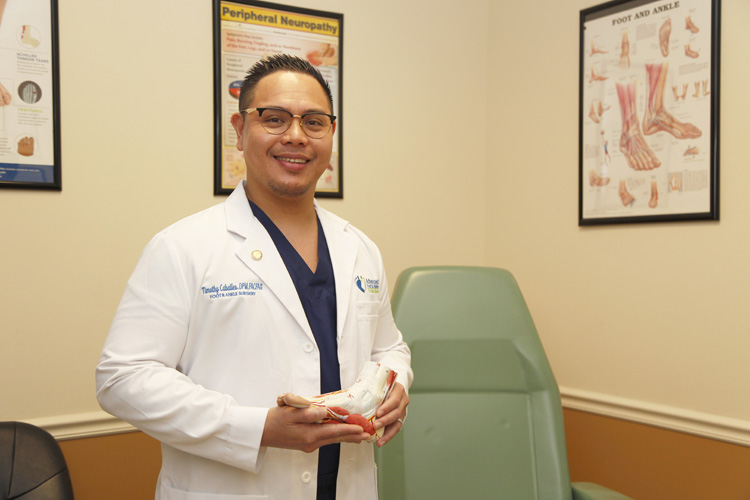
More than 21 million Americans have been diagnosed with diabetes, and roughly 20 percent of those will develop – or already have developed – an ulcer in one of their extremities. Usually the foot.
A huge proportion of that subset are over the age of 65 which is, essentially, a snapshot of Vero Beach’s demographic.
Dr. Timothy Caballes, a doctor of Podiatry with Vero Beach’s Advanced Foot & Ankle of Indian River and the Wound Care Center at the Cleveland Clinic Indian River Hospital, has some advice for those people who, thanks to the COVID-19 pandemic, may be seeking to “shelter-in-place” and are trying to avoid any outside-the-home contact, including their regular wound care appointments.
“People who are sheltering in place,” says Caballes, should be aware of what are all-too-common problems for those with leg wounds. “Some of those things,” he continues, can seem innocuous including, “little contusion injuries. Meaning someone will just bump their leg or foot against an object [but] they’ll develop a bruise. They might have an underlying stress fracture or fractures. They might have a skin tear and those skin tears, especially in people that are diabetic, are very prone to infections.”
Advises Caballes: “Patients who are diabetic – that have neuropathy in their feet – cannot feel anything. So, they really have to check their shoes and look for any foreign objects. There might be pebbles. I’ve even seen nails in shoes. People have no clue that it’s laying in the sole of the shoe and then it causes infections.”
This is serious stuff.
According to the American Podiatric Medical Association, “diabetes is the leading cause of non-traumatic lower extremity amputations in the United States, and approximately 14-24 percent of patients with diabetes who develop a foot ulcer will require an amputation. Foot ulceration precedes 85 percent of diabetes-related amputations.”
Caballes says those with neuropathy who also have a foot deformity face additional danger.
“In these types of patients – people that have hammer toes, that have bunions – you’d be surprised how many times they’re wearing inappropriate type of shoe wear that might cause excess rubbing against their toes and the skin. And then they’ll get these blisters, they develop into wounds because they don’t feel it happening and then it just gets out of control.
“So, these high-risk diabetics that have neuropathy, these ones that have wounds on the bottom of their feet or even on their legs, we do typically like to see them weekly,” Caballes says. But given the current uncertainty about COVID-19, “we can set them up with a home healthcare company – especially for our patients that don’t need as much close intensive care.
“We’re actually updating our home healthcare orders and we’ll extend them out just because of these high-risk individuals over 65.”
Caballes’ top suggestion: “You want to check your feet daily. You want to do inspections every single day.
“Check your feet for any cuts, any bruises, any sores, any blisters and if you have any calluses or any corns, don’t do any bathroom surgery. Don’t try to take care of it yourself.”
While ‘bathroom surgery’ is a memorable line, perhaps his most important advice is that these patients should always have the Wound Care Center’s phone number handy or that of their own podiatrist.
“You can call the Wound Care Center. We see tons of skin tears, wounds, bottom of foot, et cetera. And it’s not just lower extremity conditions – [we also treat] upper extremity, anything that they may be concerned about.
“They see a lot of people that have cancer excision, skin biopsies removed, slow-healing wounds. Those are the type of patients that definitely can call the Wound Care Center.
“For other type of things, minor injuries, we can also see those in the office.”
Dr. Timothy Caballes is a Podiatric surgeon with Advanced Foot & Ankle of Indian River and the Wound Care Center at the Cleveland Clinic Indian River Hospital. He can be reached at his Vero office at 3735 11th Circle, Suite 201 or at his Sebastian office at 1627 U.S. 1. That number is 772-299-7009. He can also be reached at the Cleveland Clinic Wound Care Center at 772-563-4645.



